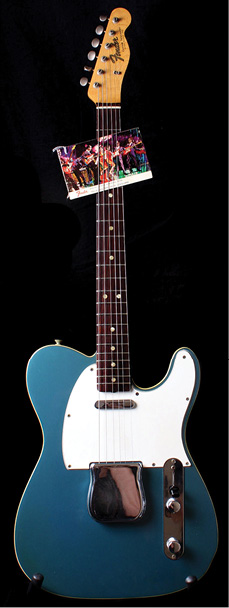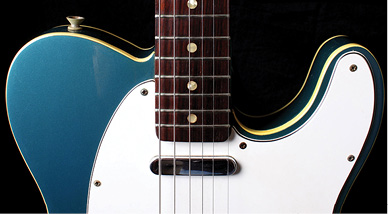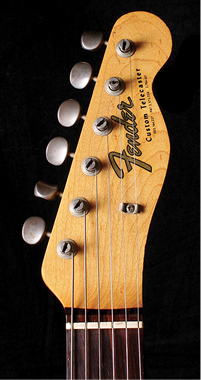LET’S MAKE A DEAL
The late sixties and early seventies were a bleak time for American instrument manufacturing. The guitar boom had been going full throttle for a number of years. Guitar-driven music had taken over the charts and the radio. The market blew up. Every kid was learning how to play “Johnny B. Goode,” and they needed guitars to play.
In trying to grab a piece of this action, almost all the big guitar companies made bad decisions about their products in pursuit of the bottom line. CBS bought Fender and Norlin bought Gibson, and the new corporate bosses proceeded to cut costs and increase production to build sales. Even the respected hundred-year-old family-owned C. F. Martin Company made cost-cutting decisions that negatively affected the quality of their instruments.
If you’re reading this book, you’re probably familiar with the lousy reputations of the guitars of the seventies. It was the era of three-bolt neck plates, pencil necks, giant rosewood bridge plates, inferior wood, cheap tuners, and poor quality control. If you haven’t heard these terms, you can just go onto the Internet and research it all—in fact, you can find out everything you’ve ever wanted to know and become an “expert” overnight.
But back then, nobody knew anything.
Nobody except the musicians, that is.
It was an inside thing. The general public didn’t know. But the hip players knew the old guitars just played better and sounded better. They would settle for nothing less. I knew this, because I was one of them. I sang and played keyboards, but I spent most of my waking hours with guitar players and bass players, while I played in bands and pursued music for many years.
But I’m getting ahead of myself in this story.
•••
When I got into this game in the late sixties, the vintage market didn’t even exist. We were making up the rules on the fly, discovering things along the way, sucking up every piece of information we could find, sometimes sharing it and sometimes not. There were no price guides, no Internet. I’d try to learn things from every source I could find, from the musicians, to pawn shops, to old repair guys who’d been fixing guitars for years. The first book to acknowledge the vintage guitar phenomenon was American Guitars by Tom Wheeler. There was also the “Rare Bird” column in Guitar Player magazine written by Robb Lawrence, but this only profiled one guitar per issue. That was it!
Over the years, as my business grew and the vintage guitar world grew, guitar shows became more popular. One of the well-known ones is Arlington. I’ve done plenty of business there. And I still do, if I’m low on some stock and need to resupply. Countless axes and millions of dollars have changed hands inside the convention center doors of Arlington. But sometimes the coolest deals go down outside the doors of Arlington.
Like, right outside.
•••
Back in 1988, my friend Chris from London and I had just finished breakfast at the hotel across the street and were making our way toward the Arlington convention center. An older fellow in a beat-up Plymouth pulled into a space near us and asked us where the entrance was. We pointed in the direction of the front door.
But, instead of heading in, we milled around like dogs on the scent to see if he had anything interesting. You never know what’s going to show up.
It took him forever to park and open his trunk, but finally he pulled out two electric guitar cases—a clean, brown Fender bass case and a non-descript Fender black guitar case.
Chris and I looked at each other, and I said, “Let’s do odds or evens to see who gets first dibs.”
Chris agreed. I lost. “Okay, which case do you want?” I said.
He laughed. “Obviously, the brown bass case.”
We asked the fellow what was inside. He told us there was a Fender Precision Bass in the brown case and a Telecaster in the other. “How much?” we asked, and he told us he wanted $600 for the bass and $450 for the Tele. Chris and I looked at each other and knew we would pay for them sight unseen.
We each handed him our money. We figured no matter what was inside we probably wouldn’t get burned.
Then came the unveiling. No matter how many times I see a case opened to reveal an unseen guitar, I still get a blast of adrenaline. It’s kind of like that old game show Let’s Make a Deal where you can either hold onto your cash or pay for whatever’s behind the curtain that “lovely Carol Merrill” is standing in front of. The curtain opens, and . . . sometimes you win the Cadillac, and sometimes you get saddled with a hundred pounds of steer manure.
The fellow unlatched the brown bass case, revealing a 1963 Fender Precision Bass. But the body had been stripped down to the natural wood. The neck was original finish, so it wasn’t a total loss. My friend Chris looked over to me and shrugged, as if to say, “Okay, that’s a decent enough deal.”
Then came my turn. Inside the generic case was a 1967 Fender Telecaster. Not just any Telecaster. I was staring at a greenish-blue Telecaster Custom with a double bound body. Unusual colors usually means its been refinished, but as I looked closely, I realized that it was a mint Telecaster Custom with its original Lake Placid blue finish! Along with its original hangtags.
You probably can guess the value and rarity of that guitar. (You’d have to guess, because I’ve never seen another one.)



Fender 1967 Telecaster. (Photos by Mark Agnesi)
My friend Chris shook his head. “You are unbelievable. I win the bet and you get the best deal.”
I can’t disagree. What would’ve happened if I hadn’t had that second cup of coffee at breakfast and didn’t come across that guy at that precise moment? What would’ve happened if I’d won the odds and evens?
They say it’s better to be lucky than to be talented. That is true. I have been supremely lucky in guitar dealings throughout my whole life. But I am lucky, because I am passionate. It required a lot of luck, as well as a lot of “pluck,” especially during those early “Wild West” years before cell phones, the Internet, and eBay.
I kept the Telecaster Custom in my personal collection for many years, and it can be seen in my first book, Norman’s Rare Guitars: 30 Years of Guitar Collecting. But eventually, one of my customers wanted it so badly, he made me an offer I couldn’t refuse. And it was quite a bit more than $450.
I started out as a musician. But ultimately my destiny lay in searching out and supplying the best instruments I could find to the best musicians and biggest stars in the business, among many other people. And I’ve developed personal relationships with all of them. It’s been a helluva ride. I sometimes pinch myself and wonder how I got here. Well, this is how . . .